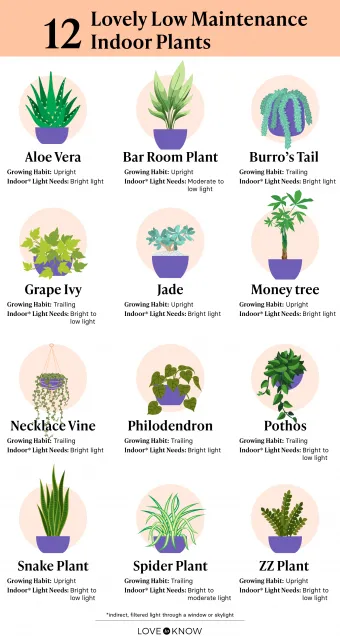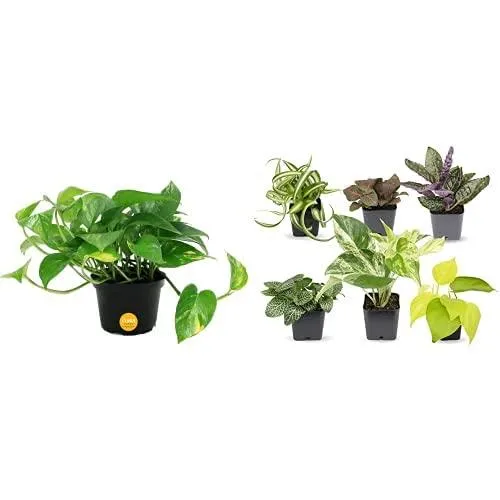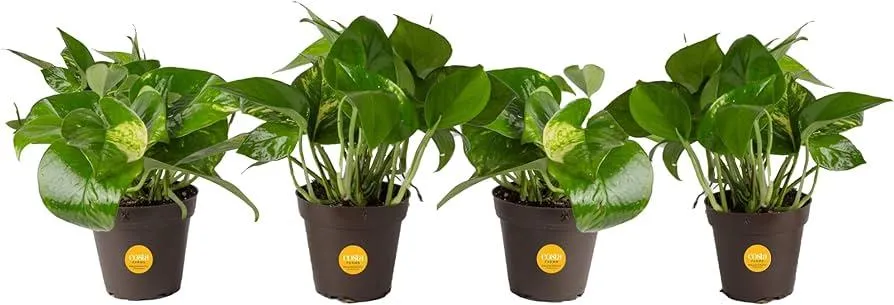The Best Low-Maintenance Indoor Plants for Beginners
If you’re looking for easy plants that thrive with minimal care, you’ve come to the right place. Growing plants indoors can be hugely rewarding, but sometimes it feels like a juggling act to keep everything alive. In this article, I’ll share my top picks for low-fuss indoor greenery along with growing tips to keep them happy and healthy.
Pothos
- Pothos is one of the most popular indoor plants for a reason – it’s practically indestructible. From my experience, this vine survives occasional neglect and thrives in low light. Its trailing habit makes it a great option for hanging baskets or letting it grow over the sides of a pot.
- To care for pothos, water only when the top inch of soil is dry. It forgives under-watering more than over-watering, so go slow. Pothos leaves sometimes develop yellow splotches if it stays too dry, so water before it gets to that point.
- Pothos is extremely low maintenance overall. It’s basically the plant equivalent of a battery that just keeps going! In terms of difficulty, pothos is rated as one of the easiest indoor plants for beginners.
Succulents
- Succulents are trendy right now for their drought tolerance and funky shapes. Some good starter succulents include jade plant, echeveria, and haworthia. The key with succulents is to water infrequently but soak the soil thoroughly each time.
- I’ve found miniature succulents arranged together in a planter or dish make a charming, low-fuss display. However, be aware that some succulents are more sensitive to overwatering than others. Err on the side of infrequent watering to avoid root rot.
- In terms of light needs, most succulents prefer bright filtered or indirect light. Place them near an east or west-facing window to keep them happy.
Snake Plant
- Snake plants are practically indestructible. Thanks to their thick, grass-like leaves, they’ll survive long periods between waterings even in low light conditions. Snake plants are said to filter toxins out of indoor air too!
- From my experience, these plants flourish with neglect. Water every 2-4 weeks depending on light and temperature. Let the soil fully dry between waterings to avoid root rot.
- Snake plants grow slowly, so don’t expect much fussiness or frequent repotting. Use a well-draining potting mix for consistent drought tolerance. Occasional fertilizer in spring and summer supports growth.
Chinese Evergreens
- Chinese evergreen varieties like aglaonema come in an array of leaf patterns and colors. They do well in low or indirect light and enjoy high humidity. Consider grouping one near your kitchen or bathroom for extra moisture.
- I’ve faced situations where aglaonema leaves develop brown tips if humidity is too low. A pebble tray or humidifier can prevent this. Water only when top inch of soil is dry to avoid root rot.
- Chinese evergreens add lush texture at a lower light requirement than many other plants. Propagate rooting stems to expand your collection!
Peperomia
- Peperomias like peperomia obtusifolia “baby rubber plant” are relatively new on the houseplant scene but spreading in popularity. These succulent-like plants come in an array of interesting leaf shapes and colors.
- They prefer medium to low light and enjoy humid conditions. Just like succulents, water peperomias whenever the top soil starts to dry out. Let the soil fully dry between waterings to maintain healthy roots.
- Peperomias make a bold geometric statement with their foliage. Display them as a tabletop specimen or group several together for visual impact.
ZZ Plant
- The ZZ plant takes the cake for neglected-plant champion. With its waxy, parallel leaves that come in green, variegated, or albino varieties, this plant thrives in very low light.
- I kid you not, some ZZ plant owners go months without watering! On the other hand, one virtually cannot overwater this plant either. Water whenever the top inch of soil starts to dry out.
- ZZ plants grow slowly but will reward attentive gardeners with flower spikes. They make a nice indoor plant that almost takes care of itself once potted up.
So in summary, those are my top recommendations for foolproof, pet-friendly, low-maintenance greenery to start your indoor plant collection. But is there such a thing as the easiest plant of all? Some say peace lilies come with the lowest bar for keeping them alive. Despite their delicate appearance, peace lilies can withstand occasional drought and neglect.
Now, are all these plants completely carefree? Of course not – all plants will eventually need repotting, pruning dead material, or may develop pests over time. But in comparison to thirstier houseplants that demand bright light and frequent watering, these options require far less intensive care while adding vibrant colors and textures to your space.

With a few plant picks from the above list, any beginner gardener can enjoy nurturing a budget-friendly indoor jungle. Just provide each with its preferred growing conditions and be attentive without going overboard. Soon you’ll find caring for your plant friends is less work than you may have expected! Let me know if you have any other plant care questions.
Top Ranked Easy Indoor Plants
| Plant | Water Needs | Light Needs | Time to Grow | Notes |
|---|---|---|---|---|
| Pothos | Low – Water when top soil is dry | Low – Thrives in low light areas | Fast – Starts growing quickly | Hardy, long vines good for hanging |
| Spider plant | Low – Let soil dry between waterings | Low-Medium – Does well in bright indirect light | Medium – New plantlets form within months | Produces small plants from leaf tips |
| Snake plant | Very low – Let soil dry completely | Very low – Tolerates low light best | Slow – Takes over 1 year to see growth | Air purifying, hardy, thrives with neglect |
| Peace lily | Medium – Keep soil moist | Medium – Prefers medium to low light | Fast – Blooms within months | Fragrant flowers, signs of underwatering |
| Chinese evergreen | Low – Water when topsoil is dry | Medium – Does well in medium light | Medium – Steady growth each year | Colorful foliage, avoid direct sun |
FAQ
-
What are some easy plants to grow inside?
Basically, some of the simplest plants to grow inside include peace lilies, pothos, spider plants, snake plants and English ivy. These plants are quite forgiving and don’t need too much care.

-
Do I need a green thumb to grow indoor plants?
Not at all! While a green thumb can help, there are lots of plant varieties that even the blackest of thumbs can keep alive. Pothos, snake plants and zz plants don’t need a lot of attention. Just water them when the soil gets dry. Perhaps call a plant friend if you kill everything – they may have tips!
-
How much sunlight do indoor plants need?
Most household plants need medium to low light. Pothos, peace lilies and spider plants can thrive in medium light areas, like a few feet away from a window. Snake plants and zz plants will also survive in low-light corners. However, some varieties like Chinese evergreen may need a south or west window to shine.
On the other hand, too little sun is usually better than too much direct light, which can scorch leaves. Rotate plants sometimes if they lean towards the brightness.

-
What size pot do indoor plants need?
Pot size will depend on the type and size of the plant. As a general rule, choose a pot one size larger than the plant‘s current container. Going up only an inch or two is fine. Crowding roots in too small a pot can stunt growth. However, too large a pot may keep the soil constantly moist, leading to root rot. Perhaps start with a petite plant and wide pot for beginners.
-
How often should I water indoor plants?
The frequency of watering varies considerably depending on the plant type, pot size, light conditions and season. Ultimately, you want to water when the topsoil becomes dry to the touch. Pothos, spider plants and snake plants can go longer between drinks. Peace lilies, on the other hand, prefer consistently moist soil. Stick your finger in the dirt to check moisture levels until you learn the needs of each plant. Overwatering can cause as many problems as underwatering.
-
How do I know if my indoor plant needs fertilizer?
Most indoor plants do well with occasional fertilizing during their growing season, which is spring through fall. Signs a plant may need food include yellowish leaves, stunted growth or flowers that drop prematurely. Look for a balanced houseplant fertilizer and follow label directions, only feeding during the growing months. Flying by the seat of your pants and trusting your gut is chill too. If the plant seems healthy otherwise, it probably doesn’t need extra nutrients.

